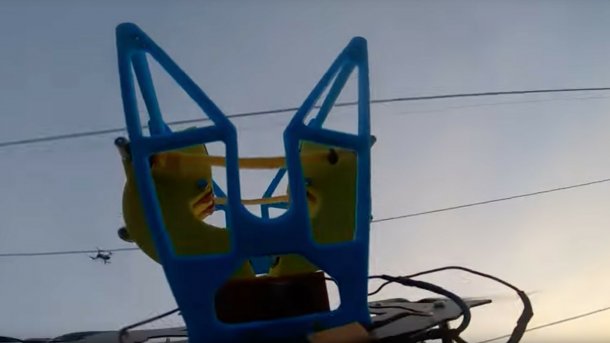Inspection drone draws power from overhead power lines for charging
An inspection drone for high-voltage cables must be able to be charged as close as possible to the line. Why not use the power from the lines?

An inspection drone docks onto a high-voltage power line for charging.
(Bild: Drone Infrastructure Inspection & Interaction Group (Screenshot))
Scientists at the University of Southern Denmark (SDU) have developed a drone that can obtain the power it needs to recharge its batteries from overhead power lines. The drone no longer has to return to a special recharging station and can therefore recharge almost anywhere and stay in the air practically forever. Using artificial intelligence (AI), the drone recognizes the high-voltage cables and docks onto them from below in order to then suck up electricity inductively.
The engineers' aim was to develop a drone that can carry out tasks completely autonomously over long periods of time without the need for human intervention. The SDU researchers describe their concept in the scientific paper "Autonomous Overhead Powerline Recharging for Uninterrupted Drone Operation" (PDF), which has been published in the journal 2024 IEEE International Conference on Robotics and Automation (ICRA 2024).
The idea of tapping into high-voltage power lines to recharge drone batteries originated back in 2017, when Emad Ebeid, a professor at SDU, was investigating ways to inspect overhead power lines. He realized that the usual inspection effort with helicopters and ground personnel at the time was disproportionately high - both in terms of efficiency and cost. As an alternative, he proposed drones to take over the inspection tasks. They could fly remotely or autonomously and monitor the pipelines.
However, the short flight duration of the drones proved to be an obstacle due to their limited battery power. Drones that were suitable for this purpose at industrial level only lasted around 30 minutes, 40 minutes at most. A way therefore had to be found to recharge the battery regularly without having to fly to a base. This was to be done via the high-voltage power lines to which the drones dock independently.
Docking and inductive charging
The Danish researchers first set about solving the problem of how the drone can dock safely to an overhead power line. To do this, the researchers used an AI to detect a high-voltage cable. It analyzes the environment recorded with a camera and detects the high-voltage cables using object recognition. The drone approaches the line from below, which has proven to be the safest method. Lidar sensors help to detect the lines to ensure a precise approach. The drone then holds on to the line with an insulated gripper. An electromagnetic mechanism snaps shut without the need for motors. This saves weight.
Empfohlener redaktioneller Inhalt
Mit Ihrer Zustimmmung wird hier ein externes YouTube-Video (Google Ireland Limited) geladen.
Ich bin damit einverstanden, dass mir externe Inhalte angezeigt werden. Damit können personenbezogene Daten an Drittplattformen (Google Ireland Limited) übermittelt werden. Mehr dazu in unserer Datenschutzerklärung.
The drone draws energy inductively from the cable. This is the only way to bring the high voltage of 1000 to 800,000 volts to the level required for charging without the need for a special (and heavy) transformer.
"Charging is inductive and therefore only depends on the current and not on the voltage of the power line," says the team, explaining the process.
Depending on the amperage, the drone, which weighs around 4.3 kilograms and has a 7000 mAh battery, has to be charged for between 30 minutes and six hours on a power line. Once this is done, the drone detaches itself from the line and can continue its service. If the battery energy falls below a certain threshold, the drone switches back to search and capture mode and looks for the next power line to recharge.
Read also
Laser lädt Drohne auf
(olb)